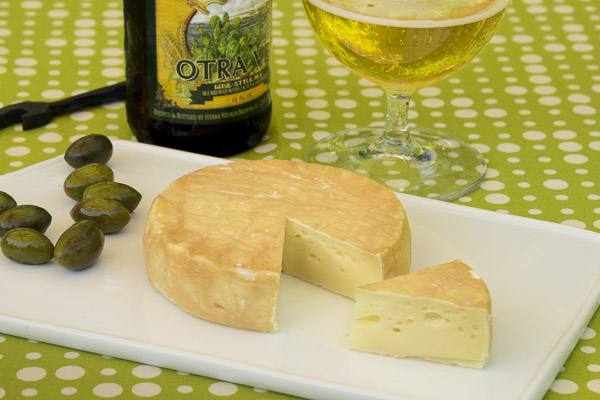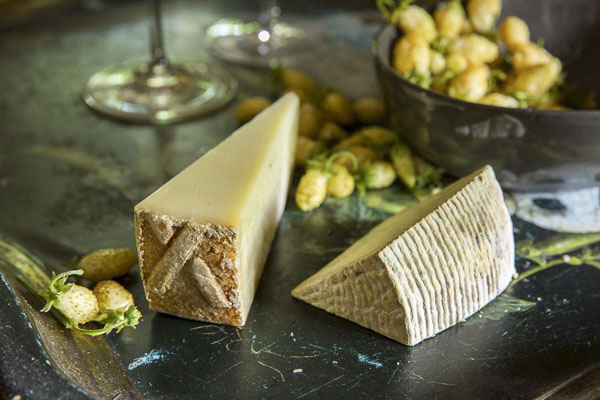Many cheesemakers and brewers know that their products are better together. But lately some American artisan cheesemakers are taking the relationship further. By washing their cheese with local brews, they’re producing some unique one-off wheels that deserve a permanent place in the firmament. Jasper Hill’s Gose-Washed Willoughby, part of a new beer-themed series from this Vermont creamery, proves how rewarding the collaboration can be.
Read moreSayonara to the Raw-Milk Rule?
Raw-milk beauties: Scharfe Maxx and Bleating Heart Fat Bottom Girl/Meg Smith Photography
It’s looking like the days are numbered for the FDA’s 60-day rule. Introduced in 1949 to protect public health, the regulation requires all cheeses—domestic or imported—made with unpasteurized milk to be matured for at least 60 days. Conventional wisdom held that cheeses aged that long would be too dry, acidic or salty to harbor deadly bacteria like Listeria and Salmonella.
Read moreTop of the Mountain
Cheese champ: Chris Roelli
For cheesemaker Chris Roelli, last week’s American Cheese Society “Best of Show” ribbon must feel like sweet vindication. Roelli spent years trying to persuade his father to get back in the business after the elder Roelli shuttered his Wisconsin cheese plant in 1991. The family had struggled to make a living producing commodity Cheddar and other low-priced cheese—the type that ends up shredded on a fast-food taco. “When we closed the doors, we were making literally a penny a pound,” Chris told me.
Read moreCheese Wizard
Bayley Hazen Blue|Meg Smith Photography
Developing a taste for cheese is easy. Understanding cheese science? Not so much. The chemistry behind cheese is complex and still holds many mysteries for dairy scientists. Recently, I stumbled on a new blog, Cheese Science Toolkit, aimed expressly at people like me—people ill-equipped to wade through technical journals but hungry for more detail than the popular press gives.
Read moreHaute Goat
Such a sad moment for France right now and for those of us who kick-started our culinary careers there. I first learned to appreciate cheese as a college student in Provence—I certainly didn’t grow up with the good stuff—and I had my first encounter with a cheese course in France. At farmers’ markets in Aix-en-Provence, I discovered goat cheeses as quivery as custard and others as hard as rocks. And I began to suspect that I would never exhaust the country’s cheese repertoire.
Read moreWine Family's Awesome Cheeses
Mostly goat: Velvet Sister
Nothing makes cheese taste better than seeing the place where it’s made. Alas, most American creameries don’t welcome visitors. Sanitation is the main issue, and few small producers have the staff for tours. But in California’s scenic Anderson Valley, Pennyroyal Farmstead Cheese is charting a different course. In March, the three-year-old Boonville creamery opened a tasting room and began offering tours. From anywhere, it’s worth the journey.
Read moreWorth the Wait
Meg Smith Photography
It’s hard to imagine how pitiful the American cheese scene would be without immigrants. No Spanish, Dutch, English, Swiss, Italians or Germans? All right then: no cows, goats or sheep. Europeans introduced them all. We would have no Dutch Holstein, English Jersey or Brown Swiss cows. No Spanish La Mancha or Swiss Saanen goats. No Vella Dry Jack or Calabro hand-dipped ricotta (Italian), no Widmer’s Cheddar (Swiss), Cacique Cotija (Mexican) or Marieke Gouda (Dutch). How sad is that?
Read moreAlmost Perfect
Meg Smith Photography
How do you make the world’s best cheese? For one answer, I turned to Marc Druart, master cheesemaker and senior director of R&D for Emmi Roth USA. Roth’s Grand Cru Surchoix scored highest (98.882 points) at this year’s World Championship Cheese Contest, which makes it the World Champion Cheese. I wanted to know how you transform cow’s milk into a wheel that’s just one point shy of perfect.
Read moreWild Kingdom
Meg Smith Photography
Get a hand lens ready. You’re going to want to take a closer look at this astonishing cheese rind. It is quite the wild kingdom, a thick crust of colorful, coexisting microbes. I’m not sure I have ever seen a more riveting surface on a cheese: suede gray, dusty brown, ivory, powdery yellow and rust.
Read moreThe Other Grilled Cheese
The typical grilled cheese sandwich never sees a grill. A panini press, maybe. Or a cast-iron skillet. Or a griddle. But for that flame-kissed taste, you need the grill.
Read more








